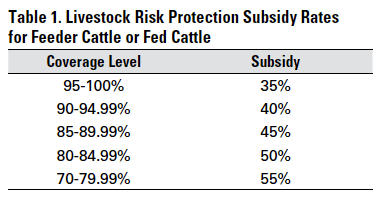Navigating Business Risks with Bagley Risk Management
Navigating Business Risks with Bagley Risk Management
Blog Article
Secret Aspects to Take Into Consideration When Finding Animals Threat Defense (LRP) Insurance Policy
When reviewing choices for Livestock Danger Defense (LRP) insurance coverage, numerous essential variables require mindful consideration to make certain effective danger management in the agricultural market. Choosing the best insurance coverage choices customized to your specific livestock procedure is extremely important, as is understanding exactly how exceptional expenses associate with the degree of protection used.
Insurance Coverage Options
When considering Livestock Threat Defense (LRP) insurance, it is vital to understand the various protection choices readily available to mitigate risks in the agricultural sector. Livestock Danger Security (LRP) insurance policy supplies different coverage options tailored to satisfy the varied requirements of livestock producers. Bagley Risk Management. One of the main insurance coverage alternatives is rate coverage, which safeguards against a decline in market value. Producers can select the protection degree that straightens with their rate threat monitoring objectives, enabling them to protect their operations against potential economic losses.
Another vital insurance coverage choice is the endorsement duration, which determines the size of time the insurance coverage is in impact. Producers can select the recommendation period that best matches their production cycle and market problems. Furthermore, insurance coverage degrees and rates differ based on the kind of livestock being guaranteed, providing producers the flexibility to tailor their insurance coverage plans according to their details demands.
Recognizing the different coverage alternatives offered under Livestock Danger Protection (LRP) insurance policy is important for manufacturers to make educated choices that efficiently secure their livestock procedures from market uncertainties.
Costs Costs

Livestock Risk Defense (LRP) insurance coverage provides necessary protection choices tailored to minimize threats in the agricultural sector, with a significant facet to think about being the estimation and framework of premium costs. These consist of the type and number of livestock being guaranteed, the protection level picked, the present market prices, historic cost data, and the size of the coverage duration.
Premium expenses for LRP insurance are commonly determined based on actuarial information and run the risk of assessment versions. Insurance companies evaluate historic data on animals prices and manufacturing expenses to identify an ideal premium that mirrors the level of threat involved. It is necessary for livestock manufacturers to meticulously assess premium prices and protection alternatives to ensure they are appropriately safeguarded versus potential economic losses as a result of unfavorable market problems or unpredicted events. By comprehending just how premium prices are calculated and structured, manufacturers can make informed decisions when choosing the appropriate LRP insurance plan for their procedure.
Eligible Livestock
The determination of qualified animals for Livestock Threat Protection (LRP) insurance policy protection entails careful factor to consider of certain requirements and qualities. Animals types that are usually eligible for LRP insurance policy include feeder livestock, fed lambs, livestock, and swine.
Feeder livestock, for instance, are frequently eligible for LRP insurance coverage if they fall within defined weight ranges. Lambs are one more group of livestock that can be thought about for LRP insurance policy, with elements such as weight and age playing a critical duty in identifying their eligibility.
Before picking LRP insurance for livestock, producers need to carefully review the eligibility requirements laid out by the insurance company to guarantee their pets meet the required demands for protection.
Plan Adaptability
Policy flexibility in Animals Danger Protection (LRP) insurance policy enables manufacturers to tailor insurance coverage to fit their specific requirements and risk monitoring techniques. This adaptability empowers animals producers to personalize their insurance policies based on aspects such as the type of livestock they possess, market conditions, and private risk tolerance degrees. By offering adjustable alternatives, LRP insurance policy enables manufacturers to successfully manage their danger direct exposure while safeguarding their livestock procedures versus unpredicted market volatility.
Insurance Claims Refine
Upon experiencing a loss or damages, producers can initiate the insurance claims procedure for their Animals Risk Security (LRP) insurance by quickly calling their insurance policy supplier. It is crucial for producers to report the loss immediately to quicken the cases process. When connecting to the insurance service provider, producers will need to give thorough information about the incident, including the date, nature of the loss, and any type of appropriate paperwork such as vet documents or market value.

After the evaluation is full, the insurance coverage copyright will make a choice regarding the visit this site right here insurance claim and connect the outcome to the manufacturer. If the case is authorized, the manufacturer will certainly receive payment according to the regards to their Animals Risk Security (LRP) insurance plan. Bagley Risk Management. It is important for producers to be acquainted with the cases procedure to ensure a smooth experience in the event of a loss

Conclusion
In conclusion, when selecting Animals Threat Defense (LRP) insurance policy, it is necessary to take into consideration insurance coverage alternatives, premium costs, qualified livestock, plan versatility, and the claims process. These key elements will click here now aid ensure that farmers and herdsmans are effectively secured against potential threats and losses connected with their livestock procedures. Making a notified choice based on these considerations can inevitably cause better economic safety and peace of mind for animals producers.
Livestock Danger Protection (LRP) insurance policy supplies different coverage choices tailored to fulfill the diverse demands of livestock manufacturers.The determination of qualified livestock for Animals Risk Defense (LRP) insurance policy coverage entails careful factor to consider of specific standards and qualities.Plan flexibility in Animals Risk Security (LRP) insurance policy enables producers to customize coverage to fit their specific requirements and take the chance of management methods.Upon experiencing a loss or damage, producers can launch the claims process for their Animals Danger Defense (LRP) insurance by immediately calling their insurance supplier.In verdict, when selecting Livestock Threat Defense (LRP) insurance, it is vital to take into consideration protection alternatives, premium costs, eligible livestock, policy adaptability, and the cases procedure.
Report this page